Crosses in S.C.A. Heraldry
Note: The information here is current through the April, 2024
Laurel Letter of Acceptances and
Returns, so far as I was able to make it.
When the term "cross" appears in a blazon and no type is specified, it
refers to an
ordinary
made up of two lines, one horizontal and one vertical, that overlap at the
center of the field. Like most other ordinaries, a cross can can use
complex lines. It can be
divided into two or more
tinctures.
It can be be fimbriated,
voided, or
cotised. Other charges can be
placed on it, or it can overlie other charges. There are no special rules
for blazoning these particulars; it works the same way it works for any
other ordinary.
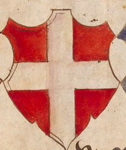
Gules, a cross argent.
from BSB Cod.icon. 390, folio 44
|
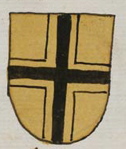
Or, a cross cotised sable.
from SGS Cod. Sang 1084, folio 27
|
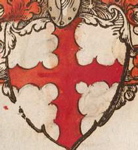
Argent, a cross engrailed gules.
from BSB Cod.icon. 390, folio 792
|
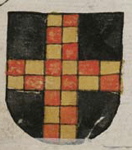
Sable, a cross compony counter-compony Or and gules.
from SGS Cod. Sang 1084, folio 35
|

Gules, on a cross argent five roundels gules pierced Or.
from BSB Cod.icon. 291, folio 26r
|
A cross, like a fess, a saltire, or a chevron, can be also be
couped. That is, the ends of the
arms can be cut short, so that they don't reach the edges of the shield.
Such crosses are simple variants of the ordinary.
Where things really begin to get complicated is in the plethora of
specialty crosses that were recognized in period
heraldry as independent charges, the smaller but significant number of
modern crosses inspired by these or by period
motifs or artifacts that are part of S.C.A. heraldry, and all the
optional treatments that can be used to
distinguish crosses of the same types from one another. Add in the fact
that the characteristics of certain types of crosses can be
combined, with or without additional
treatments, to create doubly- and triply-complex variants, and dealing
with crosses as a category quickly becomes one of the most befuddling
aspects of heraldry in the Society.
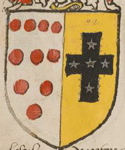
Per pale argent, in pile ten torteaus, and Or, on a cross couped
engrailed sable five mullets argent.
from BSB Cod.icon. 291, folio 15v
|
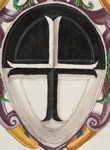
Per fess sable and argent, a cross moline countercharged.
from BSB Cod.icon. 273, folio 126r
|
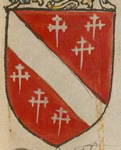
Gules, a bend between six crosses crosslet fitchy argent.
from BSB Cod.icon. 291, folio 24r
|

Argent, a cross bottony nowy quadrate and on a chief Or an eagle
sable.
from BSB Cod.icon. 270, folio 164r
|

Quarterly argent and gules, four crosses formy counterchanged.
from BSB Cod.icon. 291, folio 22r
|
To simplify the conflict-checking process, the sovereigns at arms have
grouped a number of the most common period cross types into "famillies"
. Any cross included in one of these families is considered to be
substantially changed (as defined in
Part A.5 of the S.C.A's
Standards for Evaluation of Names and Armory) from any cross in any other
family. But not every sort of cross that can be registered is included in
this list, and not every pair of types that are substantially changed from
one another is represented. Crosses that aren't part of any family must be
compared one-to-one with each other and with family crosses when conflict
checks are done. Comparisons that have been weighed by the sovereigns at
arms in the past are mentioned in the
precedents, but there are plenty of types of cross that they've never
had reason to constrast with one another.
The sovereigns at arms have established a few general principles that can
be applied when crosses are checked for conflict.
"Standard period variants of a particular style of cross will not be
considered separate; no difference is granted for
fitching, changing between
equal-armed and Latinate, etc."
(cover
letter to the May, 2009 LoAR)
"While we give a CD for a standard cross throughout versus a cross
couped, for most crosses. . .we
do not give such difference for couped versus
throughout."
(February,
2002 LoAR) [There are some exceptions.]
"Adding or removing a. . .tertiary. . .charge group is a distinct change
(DC)." (SENA Part
A.5.G.2) [A
tertiary charge group is any group of charges placed entirely on other
charges, which includes charges on crosses.]
And there are some general rules about crosses and period style,
including these:
"A cross of any type should either be
throughout on all arms or
not throughout on any of them."
(July,
2004 LoAR)
"The default crusilly is of crosses crosslet."
(August,
2002 LoAR) ["Crusilly" means "semy of crosses"—that is,
'having multiple crosses scattered over it.']
"While SCA-variant charges are often considered acceptable
('period-compatible', as it were), we draw the line at variants of
SCA-variants."
(November,
1992 LoAR)
"The SCA allows crosses of all sorts to be charged. . .."
(April,
2002 LoAR)
"A cross throughout which
overlies the line of division on a quarterly field does not remove the
appearance of
marshalling by quartering, even if the cross throughout is treated
with a complex line
(such as engrailed) or has complex ends (such as
formy or
moline.) A cross which is not
throughout, or which does not overlie the quarterly line of division
(such as a Tau cross), will remove
the appearance of marshalling unless evidence is presented that the
cross under discussion was used for marshalling in period heraldry."
(June,
2003 LoAR)
Because, "It is poor style to use two similar but non-identical
charges in a single group," the use of two different types of crosses
in a single charge group is grounds for return.
(July, 1991
LoAR, June,
1995 LoAR)
"[A]ny non-ordinary cross used as a charge, is not an
ordinary
and thus cannot be
counterchanged over an ordinary. . .."
(May,
2006 LoAR)
On a tower or castle, "Cross that appear to be arrow slits, such as
plain crosses and crosses
pometty, will be treated as architectural details - not as
tertiary charges,"
(January,
2008 LoAR), and "artistic details are allowed to have poor
contrast,"
(November,
2009 LoAR).
These broad ideas, combined with the precedents related to specific cross
types that I've collected in the tables that make up the bulk of this
article, should help anyone who's considering submitting armory that
contains one or more crosses get a head start on researching any issues
with them that are likely to arise. Use the lists below to navigate
directly to information on a cross type that interests you, or browse
through the images on the table pages if you aren't sure what the cross
you're considering is called.
Note: I've tried to index every term that appears in a registered blazon
or precedent, so that someone looking for more information on one can
easily find it. That means that some types of crosses are listed more than
once, under different terms that have been used to describe them. So if
you click on one term and find yourself routed to a table entry headed
with another, read the entry. Odds are the term you're investigating is an
alternate blazon.
Crosses and Modifications Mentioned in Precedents or Registered without
Comment by the S.C.A. College of Arms
This page was written and is maintained by
Coblaith Muimnech, who created
and owns the copyright to all portion not attributed to others. You may
print or electronically copy it for your own use or to pass on to others,
provided you do not seek to profit from its distribution.
Click to visit Coblaith's homepage or
the index to her heraldry
articles.
Click any of the above illustrations to see them in thier original contexts.
The cited manuscripts are:
-
BSB Cod.icon 270:
-
a book of arms of northern Italian cities and Milanese nobility made in
Italy in the 16th century, now in the collection of the Bavarian State
Library
-
BSB Cod.icon. 273:
-
a book of arms of the Venetian nobility made in Italy in the 16th century,
now in the collection of the Bavarian State Library
-
BSB Cod.icon. 291:
-
a book of English arms made in England in the middle of the 16th century,
now in the collection of the Bavarian State Library
-
BSB Cod.icon. 390:
-
an armorial of the Holy Roman Empire made by Stephen Brechtel in Nürnberg
between 1554 and 1568, now in the collection of the Bavarian State Library
-
SGS Cod. Sang. 1084:
-
an armorial made by Hans Haggenberg for Ulrich Rösch, abbot of Saint
Gall's, in the 15th century, now in the collection of the St. Gall abbey
library









